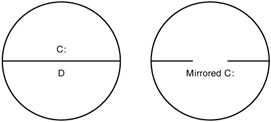Creation of Fault-Tolerant Disk Systems
|
| < Day Day Up > |
|
While the disk arrangements discussed above have many benefits, none of them offers fault tolerance. What is fault tolerance? Basically, it means that the computer is able to tolerate a fault of some kind, such as data loss or the failure of one disk; despite such a hiccup, the system is able to continue without impacting the user community. To add fault tolerance, one must create mirrored volumes or RAID-5 volumes.
Mirrored Volumes
Mirrored volumes (also known as RAID-1) are obtained by recording the same data onto two disks simultaneously. If one disk fails, the data is available on the other one, thus ensuring no data loss. This fault-tolerant arrangement has some disadvantages, however. To eliminate many of the potential problems, it is advisable to use only disks of the same size, model, and manufacturer. Further, when mirroring data, be sure to assign the same drive letter to each disk. Mirrored volumes aid throughput on high-load systems (see Exhibit 2).
Exhibit 2: Mirrored Volume (The data on one disk in the C: volume is also written into a mirrored volume on another disk.)

RAID-5 Volumes
The RAID-5 fault-tolerant setup has data and parity striped intermittently across three or more disks. This arrangement provides better read performance, as data is read from three or more disks at the same time. Also, RAID-5 provides redundancy at a cost of only one additional disk for the whole volume.
|
| < Day Day Up > |
|
EAN: N/A
Pages: 197